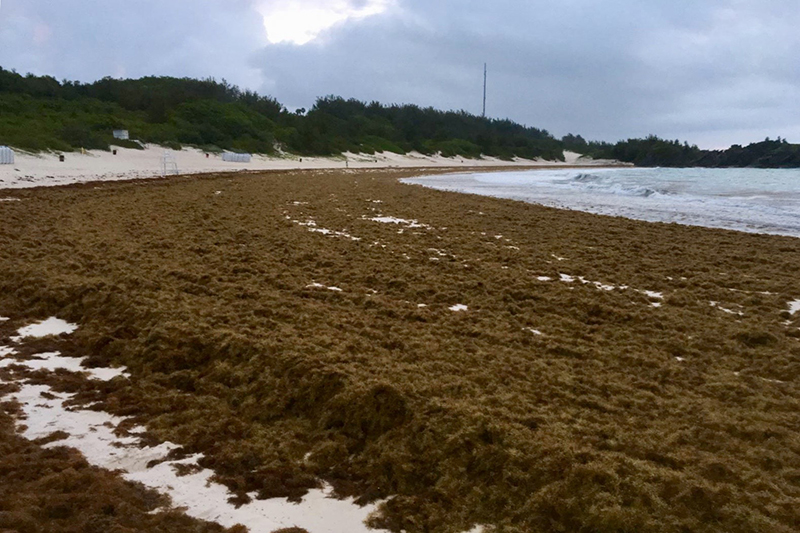Crews Working To Remove Sargassum Seaweed
The Department of Environment and Natural Resources addressed the large quantities of sargassum seaweed found on Bermuda’s beaches recently, saying that “crews and private contractors are working to remove as much Sargassum as possible.”
A spokesperson said, “The Department of Environment and Natural Resources would like to advise the public of the following regarding Sargassum seaweed in Bermuda.
“Sargassum seaweed is an import ecological habitat in our ocean, supporting hundreds of species of marine invertebrate, fishes and sea turtles. The large quantity that has stranded on our shores over the past two weeks is not unprecedented, with our last large inundation event occurring in December 2011. This seaweed is a simple plant that can grow when conditions are favourable.”
“In spring and early summer the water temperature rises, daylight hours increase and these conditions promote growth. However, as a floating plant it is subject to the effects of wind and currents in the ocean that can either disperse or aggregate the plants. We seem to have a period when these forces have conspired to create a significant aggregation, which causes a nuisance on our beaches because of the unusual quantity.
“Sargassum inundations have plagued most of the islands and coastlines in the Caribbean since 2015 but it caused by a slightly different species of Sargassum, which has not arrived here this year. Bermuda can manage normal amounts of Sargassum stranding on our beaches by raking and burying it at the back of the beach.
“The deposition of Sargassum is beneficial as it helps stabilise beach sand movement during storm events. Sargassum is a very useful garden fertiliser and scores of Bermudians have been harvesting it, although the amount of plastic that has to be removed is disturbing.
“We appreciate the patience of our visitors and local beach-goers as our hotels and the Bermuda Government’s Parks Department and Works and Engineering crews and private contractors are working to remove as much Sargassum as possible but some beaches are inaccessible to tractors.”
Read More About
Category: All, Environment, News




They should start in the House with removing Sarcasim
…………….
Saw this in 2011, but recent research indicates this plant is been used for centuries by Japanese, Chinese and other Asian nations. Great benefits, collect some wash out the salt, put it in the gardens or eat as a vegetable. Links below
https://www.healthline.com/nutrition/benefits-of-seaweed#section9
https://www.telegraph.co.uk/foodanddrink/foodanddrinkadvice/11636829/Slimy-but-nutritious-why-we-need-to-eat-more-seaweed.html
https://homeguides.sfgate.com/effects-seaweed-fertilizer-growth-plants-60197.html
It’s messing up de fishing too!
No it does not harm the fish, they live in the ocean with the seaweed and other sea plants. Yes it’s looks ugly,it is mother nature taking care of the beaches from erosion during hurricane season. Maybe a very high tide would have carried it out to the sea to the coral reefs which is good for the enviornment.
Fish and fishing are two different things. Shalom.
Yes, pushing it back to the back of the beaches and burying it is the right thing to do. We should not be removing it. It is the only thing that stabalises the dunes. It is meant to remain on the beaches and is has a vital importance to the ecosystem of our beaches. Without it we would have serious erosion and loss of our beaches. It sounds like they are doing the right thing!